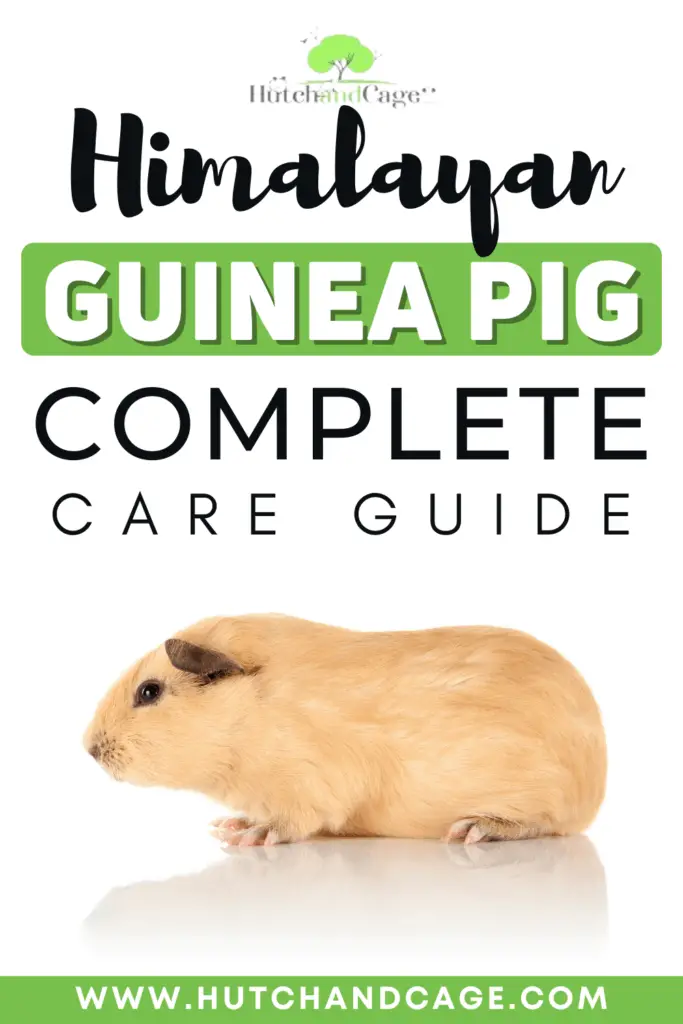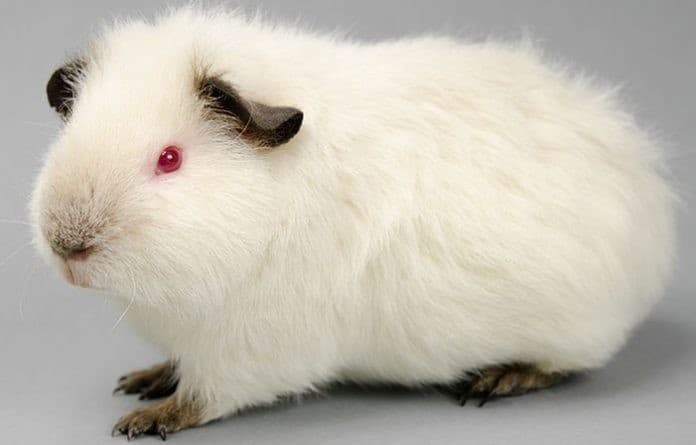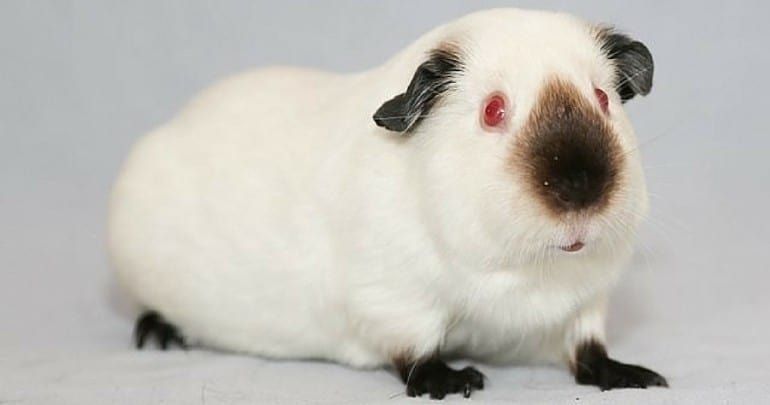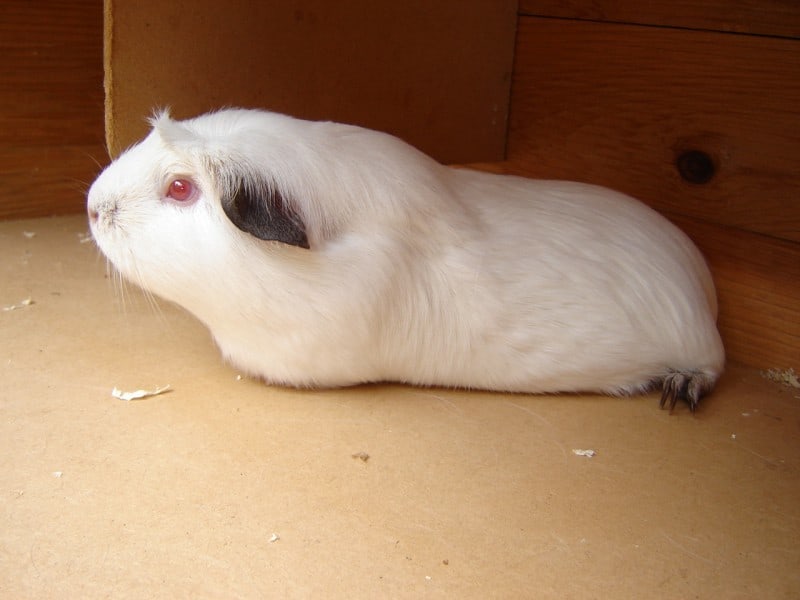Himalayan Guinea Pigs are an albino guinea pig variety. The fuzzy little creature is born with red eyes, and fur that is uniformly white. As they age, Himalayan Guinea Pigs develop dark coloring around their eyes, on their paws, and on their noses. These are called points. This is similar to what Siamese cats experience.
These unique features combine to give the Himalayan Guinea Pig a pretty extraordinary appearance. This is a huge part of the appeal of this guinea pig variety.
Table of Contents
Himalayan Guinea Pigs Like to Socialize with People
Guinea pigs travel in herds naturally, making them pack animals. Because of this, Himalayan Guinea Pigs like to be around others of their own kind, and people, instinctually. This makes them excellent pets. When they are comfortable, they are very friendly.

Himalayan Guinea Pigs prefer the company of adults and children that are older and mature enough to be calm and gentle with them. They are very sensitive, but peaceable and fairly affectionate animals.
Himalayan Guinea Pigs Are Albino and Must Avoid Sun Exposure
As with any albino creature, human or animal, Himalayan Guinea Pigs should not be exposed to direct sunlight. This will cause them to sunburn, hurt their eyes, and cause them general discomfort physically.
When a Himalayan Guinea Pig has had contact with too much sunlight, their points will begin to bleach and fade away. A symptom like this – points disappearing – indicates something is seriously wrong with the Himalayan Guinea Pig. The exception is if they are elderly. The spots do fade with age, slowly.
Otherwise, make sure your Himalayan Guinea Pig is not getting too much sun. Keep their cage somewhere moderately shady.

Himalayan Guinea Pigs have an average lifespan of 5 to 7 years, given the best possible care. These cute Guinea pigs are usually healthy but like most guinea pigs they are susceptible t
Where Do Himalayan Guinea Pigs Come From?
You won’t be blamed for thinking these Guinea pigs are from the Himalayan region as the name suggests. However, Himalayan guinea pigs are not from the Himalayan region of Asia. While it may share some physical similarities to the Siamese cat, which originated in Thailand, the Himalayan guinea pig is from South America.
Like most pets around the world, Himalayan guinea pigs were brought to Europe hundreds of years ago. From there, they made their way to North America. These Guinea pigs soon became very popular due to their Albino looks and cute nature.
How Do Himalayan Guinea Pigs Express They Are Scared Or Happy?
Himalayan Guinea Pigs are pretty expressive. When they are angry, such as in a territorial dispute, they will click their teeth in warning. When they are afraid, they may squeak in agitation or grumble unhappily.
A happy Himalayan Guinea Pig is a sight to see. They will emit whistling squeaks, called ‘wheeks,’ when they are excited. They do this at treat time especially. Himalayan Guinea Pigs will run and jump for joy, the latter of which is called ‘popcorning.’ They are interactive little fellows, and if you pay attention, they will tell you how they feel. Make sure that your Himalayan Guinea Pig is feeling secure and happy.
A Himalayan Guinea Pig Will Need A Spacious And Secure Cage
When picking out a cage for a Himalayan Guinea Pig, there are a few primary things you will want to consider: the material, the square footage, and the spacing of the bars.
Classic rodents, guinea pigs love to chew. If the cage is not resistant to this, it will result in bite marks, and constant, gradual wear. Instead, choose a cage that is made of an extremely hard, bite-proof plastic, or, better yet, metal. Metal cages, unsurprisingly, tend to last the longest out of these.
Next, be aware that guinea pigs prefer a spacious cage. After all, in nature, they are accustomed to roaming free. A 7.5 square feet cage is the minimum size recommended for a Himalayan Guinea Pig cage. 10.5 square feet or more is ideal.
Finally, find a cage with bars that are close together. Guinea pigs tend to climb and scurry and can get their paws, feet and even snouts stuck otherwise. They can even be little escape-artists and may slip out if the bars are too wide.
When placing the cage in your home, remember that guinea pigs, as social pack creatures, like to be near people – as long as the room is not too noisy. Put the cage somewhere up out of the reach of cats and dogs, as they can be too boisterous or aggressive.
Should The Himalayan Guinea Pig Have Companions In Their Cage?
Himalayan Guinea Pigs are usually pretty friendly with both humans and other guinea pigs. In fact, they prefer company. You see, in the wild, guinea pigs move about in herds. This social instinct has remained in domesticated guinea pigs today.
When paired successfully, Himalayan Guinea Pigs can be seen to groom one another, cuddle, and play. In a cage on its own, a Himalayan Guinea Pig will almost certainly be lonely.
Typically, it is advised to buy Himayalan Guinea Pigs in pairs. This is the best way to ensure they will get along, where they are familiar with each other from the beginning. Otherwise, your Guinea Pig may see a new addition as a threat to their solitary home.
Another way to help your Himalayan Guinea Pigs get along is to get one that is a bit older, or one a bit younger, since the youth will defer to the elder naturally. This will allow them to establish a hierarchy.
Needless to say, you will want same-sex Himalayan Guinea Pig pairs. Otherwise, they will breed; this should not occur until you are prepared properly. Not only this, but guinea pig pregnancies can go horribly wrong if the process is not undergone correctly.
Give Your Guinea Pig A Small House Inside The Cage
While the Himalayan Guinea Pig prefers a spacious cage, so they can move around and explore, they also like somewhere cozy to sleep and hide. This calls for a guinea pig house.
A guinea pig house is a small enclosure that can be either store-bought or homemade. There are pros and cons to both kinds. Homemade guinea pig houses are less
There are also a lot of cute designs available. It really depends on your budget and what you are looking for personally. Your Himalayan Guinea Pig will not be too picky – they just want a little, private territory to call their own. When they are nervous, this will help them feel more secure.

Bedding Is A Necessity For Himalayan Guinea Pigs
In the wild, guinea pigs are accustomed to havings dens. They fill these with natural debris, like leaves. This serves as a source of comfort and warmth primarily.
The purpose of bedding in a cage is both to mimic a natural den environment and for the sake of hygiene. You see, quality bedding will absorb both odor and liquid effectively. There are a few types that serve this purpose particularly well.
Aspen Wood Shavings Are One of the Top Guinea Pig Bedding Materials
Aspen Wood shavings are one of the top Guinea Pig bedding materials
Wood shavings can serve as a great hamster bedding material. Compared to other wood varieties, aspen wood is especially soft, as well as splinter-free. Other wood types tend to be too scratchy to serve as bedding comfortably.
Not only this, but both cedar and pine can prove harmful when used for bedding. These wood types emit fumes when they come in contact with urine. Considering that one of the main purposes of bedding is to absorb urine and other liquids, this is counterproductive.
Instead, opt for aspen wood shavings, which do not produce fumes. Quite the contrary, aspen wood shavings have a great odor-eliminating ability.
Here’s the bedding we use for our Guinea Pigs it’s called Carefresh and is available on Amazon.
When purchasing aspen wood shavings, be sure to do so at a pet store, or to get pet-grade aspen shavings online. Those from an alternative source, such as a lumberyard, are not yet sanitized, and so contain bugs, mites and the like.
A moderate-quality bag of aspen wood shavings is ideal. The cheapest brands tend to be a bit dusty.
Aspen wood shavings are one of the most affordable Himalayan Guinea Pig bedding materials out there. It is also very effective, especially for its price.
Paper is the most popular Himalayan Guinea Pig bedding material
Himalayan Guinea Pig Bedding made from paper can be purchased from the store, or created at home. At the store, there are paper pellets and natural bedding choices available. At home, you may use certain types of paper to craft paper Himalayan Guinea Pig bedding of your own.
The best papers for this are blank white computer paper or brown paper bags. Newspapers are recommended against, as the ink is toxic, and there is too much risk of a chew-happy guinea pig ingesting this. For the same reason, avoid paper with permanent marker pen or any other ink on the surface.
Once you have obtained clean white paper and/or brown paper bags, tear them into bits or put them through a shredder, and voila – an effective Himalayan Guinea Pig bedding material, that easy.
Guinea Pigs Need Vitamin C But Don’t Produce It Naturally
A unique aspect of Himalayan Guinea Pigs – and guinea pigs of all kinds – is that they cannot make their own vitamin C. Of course, vitamin C is important to most living creatures for their health and longevity. Without an alternative source of vitamin C, guinea pigs are will become unwell, and are even prone to scurvy.
To obtain the vitamin C that they require, Himalayan Guinea Pigs depend a great deal on their diet. They depend on veggies in particular for this purpose, as well as fruits. Himalayan Guinea Pigs need a certain amount of fresh produce a day. Along with this, they can have a small portion of vitamin C-fortified pellets a day.

Himalayan Guinea Pigs Should Always Have Access To Hay
Hay serves two vital purposes for the Himalayan Guinea Pig: as fiber, and as something to chew to keep their teeth in line. You see, guinea pig teeth continue to grow throughout their lifetime. With constant access to hay, guinea pigs can file their teeth down accordingly.
The fiber in the hay serves to aid in digestion for the Himalayan Guinea Pig – it keeps things running smoothly. Fiber is the greatest dietary requirement of guinea pigs, along with vitamin C. Himalayan Guinea Pigs should have access to plenty of fresh, mold-free hay every day.
The best Hay we find is Timothy Hay click here for more details.
Vegetables are healthy for Himalayan Guinea Pigs in a few ways
First and foremost, vegetables provide Himayalan Guinea Pigs with much-needed vitamin C.
Vegetables are also chock-full of fiber, not to mention vitamins, minerals and antioxidants. Veggies, fruit and greens also have high water content, to keep guinea pig kidneys nice and healthy.
Finally, crunchy vegetables are perfect for Himalayan Guinea Pigs to sink their teeth into, to aid in keeping them ground down properly.
A Himalayan Guinea Pig should have roughly one cup of fresh veggies daily.
TOP TIP: Bell Peppers are a great source of Vitamin C
Your Himalayan Guinea Pig may indulge in an array of bell peppers! Give them some of each color – every one is full of Vitamin C, and other vitamins. In fact, bell peppers are perhaps the top way for Himalayan Guinea Pigs to get the vitamin C they require.
Unlike with some veggies and most fruits, bell peppers contain very little sugar. This means your guinea pig may consume considerably more.
The Himalayan Guinea Pig may have a few generous slices of bell pepper as often as each day.
Carrots are nice and crunchy
As you can probably imagine, the crunch in carrots appeals to Himalayan Guinea Pigs. This veggie is quite useful to them for grinding their teeth down. Carrots are also high in vitamin A. This makes them a good choice for the Himalayan Guinea Pig supplementally.
Unfortunately, this means that your Himalayan Guinea Pig can also get too much vitamin A from carrots. Not only this but compared to other vegetables, carrots are a bit high in sugar.
Basically, in the proper portion (several tiny slices), carrots are one of the healthiest vegetables for Himalayan Guinea Pigs out there. In excess, they can affect a guinea pig harmfully. Once again, here, portioning is imperative.

A Fibrous and Nutritious Choice is Romaine Lettuce
Unlike iceberg lettuce, which is, in fact, unhealthy for the Himalayan Guinea Pig, romaine lettuce is very good for them nutritionally.
Romaine lettuce contains not only vitamin C but also potassium and fiber aplenty. This makes it an excellent staple for the Himalayan Guinea Pig dietarily. The darker the lettuce, the better – offer your guinea pig dark green lettuce, red lettuce, and more. Himalayan Guinea Pigs can consume lettuce every day.
Himalayan Guinea Pigs may also enjoy cucumber, cabbage, and broccoli, as well as a few other veggies, safely. Just be sure to administer the veggies in tiny, guinea pig-sized portions.
Himalayan Guinea Pigs can have fruit as a treat occasionally
Fruit is an excellent treat for Himalayan Guinea Pigs! Not only do they love the flavor, but fruit is packed with fiber, vitamin C, and other nutrients.
Whereas veggies are considered a meal or snack, fruit is considered a treat due to its high sugar content naturally. Himalayan Guinea Pigs eat primarily fiber, and little starch or sugar comparatively.
This means that their bodies are simply not equipped to deal with a lot of sugar. Because of this, in order for the Himalayan Guinea Pig to consume fruit safely, it must be portioned properly.
A tiny, guinea pig-sized portion of fruit a few times a week is recommended, ideally.
Certain fruits are higher or lower in sugar than others, and so guinea pigs may have them more or less frequently. Some also contain more or less nutrients than others. To help you out, some of the best, most beneficial fruits to feed to your Himalayan Guinea Pig are listed below.
Strawberries are full of Vitamin C
Himalayan Guinea Pigs are crazy about strawberries. Fortunately, these fruits are very good for them – in the proper serving size. A guinea pig may have a couple of small slices of strawberries two times weekly, roughly.
For the Himalayan Guinea Pig, the biggest benefit of strawberries is the high vitamin C content the fruit possesses. Strawberries also contain other vitamins and minerals and like most fruits, they are comprised largely of fiber.
It should come as no surprise, however, that this sweet fruit, for guinea pigs, is rather sugary. This is why the proper serving size is
Apples contain lots of fiber and antioxidants
An apple a day applies – on a smaller scale – to Himalayan Guinea Pigs as well as humans. Apples are not only rich in vitamins, but they are also comprised mostly of fiber, too. They are also fairly low in sugar compared to most fruits out there.
Something to keep in mind with apples, however, is that their seeds are poisonous. Specifically, they contain cyanide. In small doses, these seeds affect humans very little. Because Himalayan Guinea Pigs are so much smaller in size, the dose is much larger and will, therefore, affect them harmfully.
To prevent this, core the apple and/or remove the seeds before offering your Himalayan Guinea Pig a small slice.
Himalayan Guinea Pigs may have a small slice of two of apple up to three times weekly.
Blueberries are an excellent source of antioxidants
When offering your Himalayan Guinea Pig fruit, you won’t go wrong with blueberries. The vibrant color of the fruit indicates its high antioxidant content, and antioxidants are good for humans and guinea pigs alike.
Blueberries are also fibrous, not to mention hydrating and juicy. With your Himalayan Guinea Pig, they are sure to be a fast favorite.

You may offer your Himalayan Guinea Pig a few blueberries 1-3 times weekly.
Along with these healthy fruits, your Himalayan Guinea Pig may give pears a try. They can also have many berry varieties, including raspberries and blackberries.
Prior to offering your Himalayan Guinea Pig any fruit, refer to a reliable source to ensure it is safe specifically. Otherwise, you risk your guinea pig becoming sick or worse, as some fruits are toxic and even deadly.
Feed your Himalayan Guinea Pig pellets supplementally
Pellets are quite beneficial for Himalayan Guinea Pigs. They are made to meet the needs of guinea pigs nutritionally, as well as to provide something hard for them to chew.
Of course, for optimum nutrients, the guinea pig pellets in question must be of a decent quality. When picking out pellets, as with other pet foods, keep an eye out for fillers, and avoid these.
Himalayan Guinea Pigs may have a small portion of pellets each day. Make sure to pay close attention to the serving size on the box, as it tends to vary.
We feed our Guinea pigs Kaytee Pellets which we find all breeds of Guinea pigs love.
Give Your Himalayan Guinea Pig Water In A Bottle
For Himalayan Guinea Pigs, bowls of water simply will not do. These active critters scamper and burrow, and it is pretty much guaranteed that they will get their water dirty. Bedding especially tends to get into water bowls, becoming soggy and unsanitary.
Instead, provide your Himalayan Guinea Pig with a water bottle. This will prevent spills. Go for a steel spout and ball water bottle. Replace their water every day or two, and check that the ball has not become stuck in the spout frequently.
Foods that are poisonous to the Himalayan Guinea Pig
Some common foods that are poisonous to guinea pigs are obvious, like junk food, chocolate, and candy.
Onions and garlic are toxic to most animals, and Himalayan Guinea Pigs are included in this. In guinea pigs, these foods can cause anaphylactic shock and respiratory failure. Clearly, they must be kept far away.
Some less commonly-known poisonous foods are potatoes and all parts of potato plants. The same goes for beans and all parts of bean plants. Tomato plants are toxic to Himalayan Guinea Pigs, but the fruit itself, the tomato, is okay. Avocado skins contain compounds that, to guinea pigs, are poison.
Corn is not toxic, it is just really high in starch, and the hulls – the shells around the kernels – are impossible for guinea pigs to digest properly.
Let Your Himalayan Guinea Pig Explore Safely
Because guinea pigs are naturally used to foraging and grazing during the day, they will want to stay somewhat active. First, get a cage with a lot of space. Secondly, let your Himalayan Guinea Pig explore every once in a while. They can leave their cage as much as a few times a day, or as infrequently as a couple of times weekly.
Guinea Pig proof the area
Before you let your Himalayan Guinea Pig out of its cage, you must make sure the area is secure. This means covering any holes they could get into, putting away electrical cords they could chew, and putting potted plants up and away. These things can otherwise cause your guinea pig to come to harm or lose themselves in the house.
If you are letting your Himalayan Guinea Pig outside, make sure that it is not sunny, or too hot, or too chilly. On hot days, Himalayan Guinea Pigs can overheat; on cold ones, they will become uncomfortable. Choose a mild to warm, overcast day for a Himalayan Guinea Pig adventure.
As with indoors, remove any threats to your Himalayan Guinea Pig before letting them outdoors. Fence off garden plants that could be poisonous, or that they could eat in excess and make themselves sick. You should also keep an eye on your guinea pig while they are out there, to prevent them from such mischief.
Himalayan Guinea Pigs Need Things Especially To Chew
Along with food, Himalayan Guinea Pigs need other things to chew to keep their teeth healthy. There are many toys for this purpose at the pet store. Aspen wood sticks, blocks, etc. are a natural, toxin-free choice.
Providing something for your Himalayan Guinea Pig to chew will also benefit you, as it will – somewhat – discourage them from gnawing on other objects as much.
Use Ramps For Your Guinea Pig Instead Of An Exercise Wheel
The proper exercise wheel can make a great choice for small rodents, like rats, hamsters, etc. Guinea Pigs, on the other hand, are not as flexible. This means that when they run on the wheel, their backs do not bend as easily. Over time, the strain will lead to injury.
Of course, Himalayan Guinea Pigs still need plenty of exercise. This is one of the reasons a decent-sized cage is of such importance. Along with this, you may include ramps in the cage, to take the best advantage of the space.
Just make sure these ramps are wide enough for your Himalayan Guinea Pig to traverse easily. Place them low enough down that, should your guinea pig fall, they will not hurt themselves accidentally.
How To Breed Himalayan Guinea Pigs (Read This First)
When a male and female guinea pig are housed together, they will breed quickly. This can be a good or bad thing, depending on how prepared you are.
First of all, guinea pigs can be tricky to find appropriate homes for. Before you breed them, make sure they have somewhere to go already.
Next, be aware that there is only a small window of time during which female guinea pigs can breed safely. This is from 1-5 months of age, roughly. At around 6-8 months, female guinea pigs are no longer able to reproduce safely.
At 6-8 months, female guinea pigs become internally sealed off from producing young, yet they can still become pregnant, unfortunately. This must never be allowed to happen, or a dangerous, painful c-section becomes necessary.
To prevent unwanted pregnancy, males must be kept with males only, and females with females only.
If you are indeed ready to breed your Himalayan Guinea Pigs, it is wise to let a vet know. Be sure that your guinea pigs are the proper age, and that they are in good health. Be aware that breeding can shorten the lifespan of female guinea pigs, as it will expend a great deal of energy.
Himalayan Guinea Pig Piglets Care
Guinea pig babies are born fully-formed, have teeth, and it is not long before they can run and play. Along with nursing, they will even be able to eat adult food quickly.
These things make them a little easier to care for than some baby animals. The biggest risk is bad parenting – not too common, luckily – or illness. Keep an eye on the fragile young, known as piglets, to make sure they are not neglected and are healthy.
Summary: Beginners Guide To Keeping Himalayan Guinea Pigs
As you can see, there is a lot to love about the Himalayan Guinea Pig. The rather exotic guinea pig breed can make a lovely pet for just about anybody, the exception being small or rowdy children. Otherwise, under the right circumstances, the Himalayan Guinea Pig is happy to make friends with people and other guinea pigs alike.
In a nutshell, Himalayan Guinea Pigs are cute, friendly, interactive and affectionate, so it is no wonder they are highly sought-after, really. Give your Himalayan Guinea Pig a life with the quality care they deserve, and in return, they will provide delightful company.







